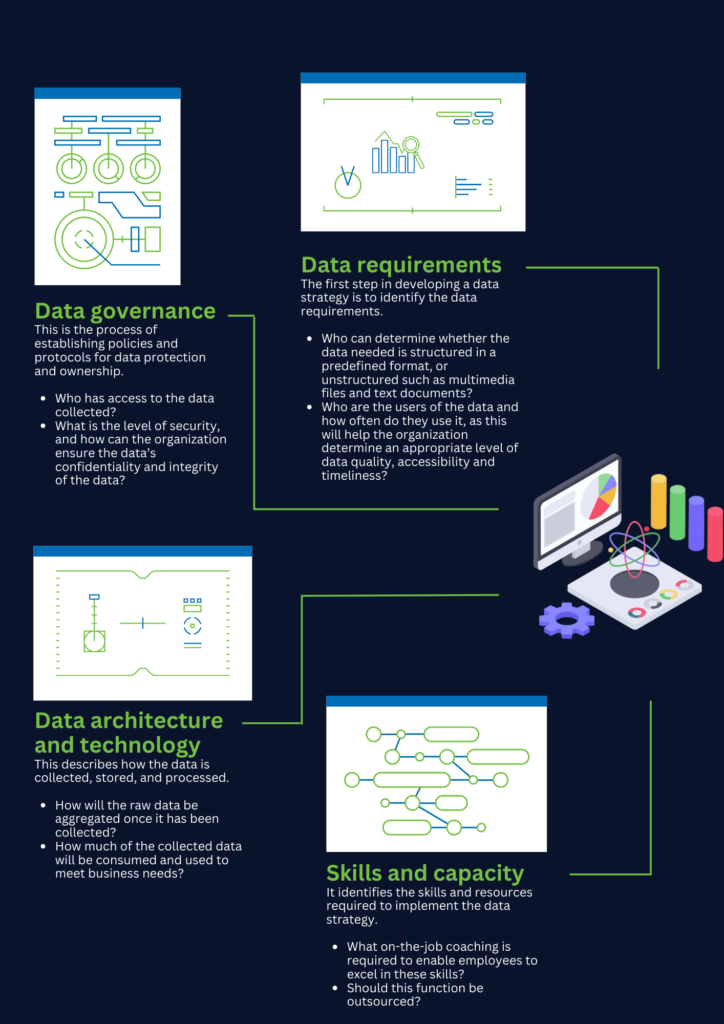This article is part of a two-part Digital Transformation series. In Part I of this series, we will delve into the role of big data and visual analytics, and examine how organisations can leverage these technologies to develop a robust data strategy.
At a Glance
- The ability to harness big data is important for organisations to make better decisions, improve operational efficiency, and innovate.
- By visualising data, organisations can gain a competitive advantage by simplifying data to reveal patterns, trends, and correlations that might not otherwise be invisible.
- Unlocking the power of big data and visual analytics in an organisation requires a well-defined data strategy.
- There are four components to a well-defined data strategy: data requirements, data governance, data architecture & technology, skills & capacity.
We live in a world awash with data. Governments and businesses are grappling with large volumes of data multiple sources. This is known as big data. The volume and complexity of data has made it increasingly difficult to extract meaningful insights at the right time. However, with the right implementation approach, organisations can centralise and transform disparate data sources.
The ability to harness big data is crucial for organisations to make better decisions, improve operational efficiency, and innovate. Enter visual analytics, a powerful tool that breaks down the barriers between your organisation and the data available to it. This tool brings relevant insights of your data and aggregates numbers into images, enabling everyone in an organisation to access and understand the complex data sets. By visualising data, organisations gain a competitive advantage because simplified data reveals patterns, trends, and correlations that might not otherwise be invisible.
Did you know?
Renoir has partnered with a prominent real estate investment fund company known for managing a diversified portfolio of real estate assets. Their portfolio includes commercial, residential, and logistics properties across Japan, China, South Korea, Australia, and Southeast Asia. With a strong emphasis on operational efficiency and risk management, the company constantly seeks opportunities to optimise its portfolio through cost-effectiveness measures and innovative approaches.
Following a thorough assessment of the business, Renoir was appointed to improve the company’s data management and technology infrastructure. For this project, we developed a comprehensive a data strategy and technology strategy that included the following key initiatives:
- Developed a data dictionary to ensure consistent understanding and use of data across the organisation.
- Established clear data model requirements, as well as guidelines for data usage and storage.
- Implemented the necessary technologies to align with and achieve the project’s objectives.
Powerful tools for businesses
Big data and visual analytics are two powerful tools that organisations can use to:
- Identify patterns and trends: Long-term data analysis reveals hidden trends, enabling predictive insights and optimising resource allocation.
- Improve decision-making: Comprehensive data understanding drives informed decisions from product development to marketing campaigns. These can lead to increased profits and improved efficiency.
- Gain insight into customer behaviour: Organisations can glean valuable insights into customer preferences by analysing customer interactions. This information can help to improve the customer experience and increase sales.
The four components of a data strategy
Unlocking the power of big data and visual analytics in an organisation requires a well-defined data strategy. The data strategy component outlines the data requirements, data governance, data architecture and technology, as well as skills and capacity to meet business needs and strategy.
When these data strategy components are met, businesses can meet their pre-established needs and strategy.
- By implementing a robust data strategy, organisations can improve operational performance through the secure management of their operations. Aligning activities with medium- and long-term integrated planning, allocating resources efficiently, and monitoring key performance indicators (KPIs) drive overall business success.
- In addition, a well-defined data strategy strengthens governance and compliance efforts. By leveraging functional capabilities, organisations can exceed safety, production, and cost related KPIs. Leveraging data-driven insights optimises operations, mitigates risk, and improves governance practices, ensuring compliance with local and international regulations, and industry standards.
- The strategic use of data and analytics enables organisations to make informed decisions. Businesses can meet cost and production targets, identify areas for improvement, and therefore, drive transformational change that aligns with their overarching goals.
- Furthermore, organisations benefit from improved strategy and overall delivery by analysing performance and aligning their actions with strategic goals, optimising the overall delivery process for greater success.
- A structured data strategy streamlines portfolio management through the development of execution roadmaps. Effective management of project portfolios ensures alignment with sustainability targets, tracks progress, and drives successful outcomes.
Stay tuned for part II of this series where we will explore the role of the data transformation approach and the digital transformation approach, particularly in the context of big data and visual analytics.
Keen to begin your digital transformation journey?











